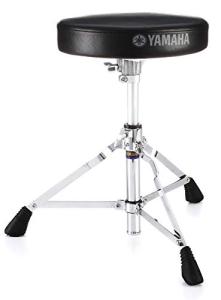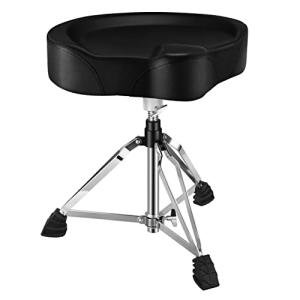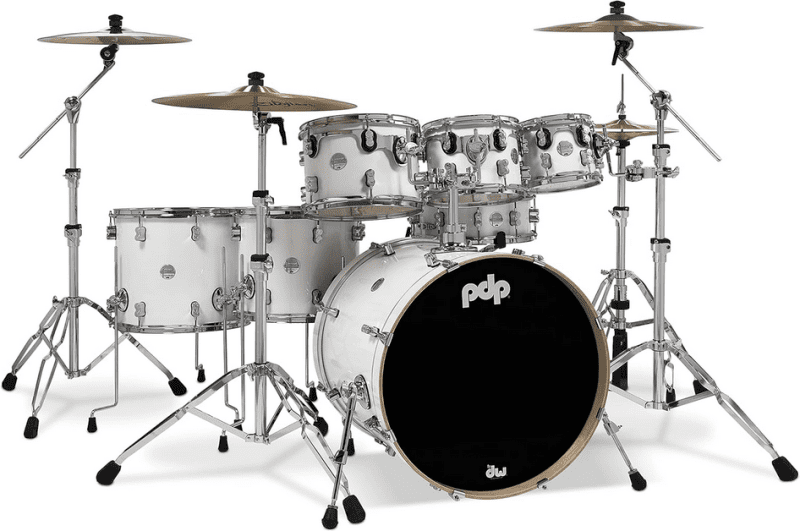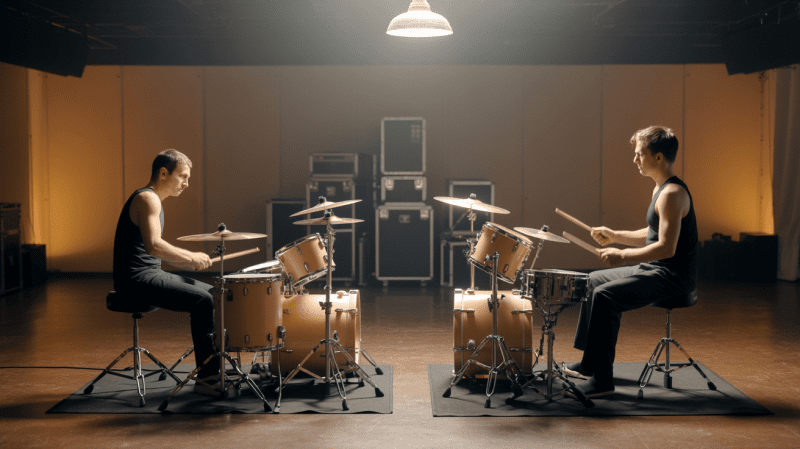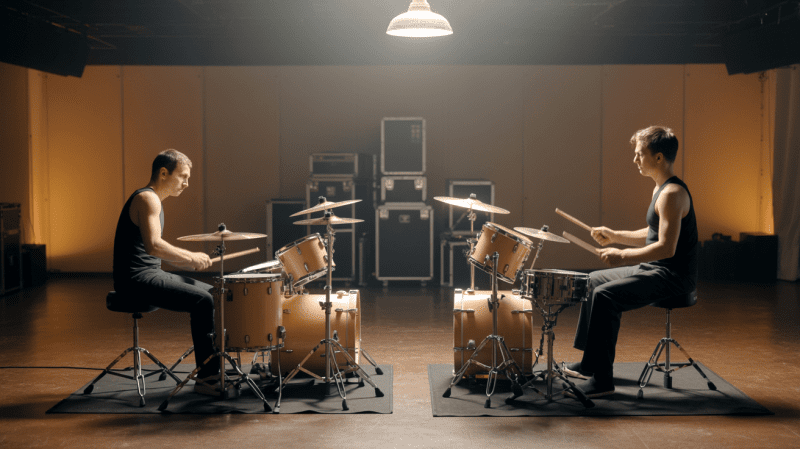If you're a drummer who loves the blues, you're in good company. Blues music has been around for over a century, and it has inspired countless musicians to pick up an instrument and start playing.
Playing drums in a blues band can be a deeply rewarding experience, but it requires a certain set of skills and knowledge.

To play drums in a blues band, you need to have a solid understanding of the fundamentals of blues drumming. This includes things like the 12-bar blues progression, the shuffle rhythm, and the importance of dynamics.
You'll also need to be comfortable playing with a band, as blues music is all about the interplay between different instruments.
Additionally, you'll need to be familiar with the different styles and drumming patterns that are commonly used in blues music.
In this article, we'll cover everything you need to know to start playing drums in a blues band. We'll go over the fundamentals of blues drumming, techniques and dynamics, playing with the band, different blues styles, and drumming patterns, and more.
Whether you're a beginner or an experienced drummer, this guide will help you take your blues drumming to the next level.
Key Takeaways
- To play drums in a blues band, you need to have a solid understanding of the fundamentals of blues drumming, including the 12-bar blues progression and the shuffle rhythm.
- Playing with a band is an essential part of blues drumming, so it's important to be comfortable with the interplay between different instruments.
- There are many different styles and drumming patterns used in blues music, so it's important to be familiar with them in order to play effectively in a blues band.
Fundamentals of Blues Drumming
To play drums in a blues band, you need to understand the fundamentals of blues drumming. In this section, we'll cover the essential elements you need to know to get started.
Understanding Blues Rhythms
Blues music is typically played in 12/8 time, which means there are 12 eighth notes in each measure. This time signature gives blues music its distinct feel, which is often described as a "swing feel."
To get a feel for this rhythm, try counting "1-and-a 2-and-a 3-and-a 4-and-a" while tapping your foot.
Essential Blues Drum Beats
There are a few essential blues drum beats you'll need to know to play in a blues band. The first is the shuffle beat, which is the foundation of most blues music.
To play the shuffle beat, you'll need to keep a steady rhythm on the hi-hat while accenting the snare drum on beats two and four.
Another essential beat is the slow blues beat, which is played in 4/4 time. This beat is slower than the shuffle beat and is often used during the slower, more emotional parts of a blues song.
To play the slow blues beat, you'll need to keep a steady rhythm on the hi-hat while accenting the snare drum on beats two and four.
Developing Groove and Feel
To play drums in a blues band, you need to focus on developing your groove and feel.
Groove refers to the overall rhythm and feel of the music, while feel refers to the emotional quality of the music.
To develop your groove, practice playing along with blues recordings and focus on locking in with the bass player.
To develop your feel, focus on playing with emotion and expression.
Technique and Dynamics

As a drummer in a blues band, your technique and dynamics play a crucial role in creating the right groove and feel for the music. Here are some tips to help you master the shuffle, incorporate ghost notes and accents, and play with intensity and volume.
Mastering the Shuffle
The shuffle is a fundamental rhythm in blues music, and mastering it is essential for any blues drummer.
To play the shuffle, you need to create a repeating pattern of three notes, with the first note lasting twice as long as the other two. The pattern is often played on the hi-hat, with the snare drum hitting on beats two and four.
To master the shuffle, start by practicing the pattern slowly, focusing on playing it evenly and smoothly. Gradually increase the tempo until you can play it comfortably at the desired speed.
Experiment with different variations of the shuffle, such as playing it on the ride cymbal or adding accents on the snare drum.
Incorporating Ghost Notes and Accents
Ghost notes and accents are an important part of blues drumming, adding depth and complexity to the rhythm.
Ghost notes are quiet, subtle notes played in between the main beats, while accents are emphasized notes that stand out in the rhythm.
To incorporate ghost notes and accents, start by practicing basic patterns and adding in variations.
For example, you could play a basic shuffle pattern and add in ghost notes on the snare drum or accents on the ride cymbal.
Experiment with different combinations of ghost notes and accents to find the right balance for the song.
Playing with Intensity and Volume
Blues music is all about intensity and emotion, and as a drummer, it's your job to create that energy.
Playing with intensity and volume means knowing when to lay back and when to push forward, and how to use dynamics to build tension and release.
To play with intensity and volume, start by experimenting with different levels of volume and playing with a range of dynamics.
Use crescendos and decrescendos to build tension and release, and don't be afraid to play with a lot of energy when the song calls for it.
Remember to listen to the other musicians and adjust your playing accordingly to create a cohesive sound.
Playing with the Band

Playing drums in a blues band is all about supporting the other musicians while still maintaining your own groove. Here are some tips to help you play effectively with the band.
Locking in with the Bass Drum
The bass drum is the foundation of the band's rhythm section. To lock in with the bass player, listen to their playing and try to match their rhythm.
You can also use the bass drum to accentuate the bass player's notes. For example, if the bass player plays a strong note, you can hit the bass drum at the same time to emphasize the note.
Supporting Soloists and Vocalists
When a soloist or vocalist is playing, your job is to support them and enhance their performance. This means playing more quietly and simplifying your rhythm to give the soloist or vocalist space to shine.
You can also use your drum fills to complement the soloist's phrasing. Listen closely to the soloist's playing and try to anticipate their next move.
Communication and Improvisation
Blues music is all about improvisation and communication between the musicians.
As a drummer, you can communicate with the other musicians by using your fills and rhythm to signal changes in the music.
For example, you can use a fill to signal the end of a solo or to lead into a new section of the song.
To improvise effectively, it's important to have a good understanding of blues patterns and rhythms.
Practice playing along with blues recordings and try to incorporate new rhythms and patterns into your playing. With practice, you'll develop the ability to communicate and improvise effectively with the band.
Blues Styles and Drumming Patterns
Exploring Different Blues Styles
Blues music has a rich history and many different regional styles. Some of the most popular blues styles include the Texas Shuffle, Chicago Blues Shuffle, Delta Traditional Slow Blues, and Funk Blues Style.
Each style has its own unique sound and drumming patterns that are essential to capturing the essence of the style.
The Texas Shuffle is a popular blues style that originated in Texas. It is characterized by a driving shuffle rhythm that is played on the snare drum, with the bass drum playing a steady quarter-note pulse. The hi-hat is played on the off-beats, giving the rhythm a syncopated feel.
The Chicago Blues Shuffle is another popular style that originated in Chicago. It is similar to the Texas Shuffle, but the snare drum is played on beats two and four instead of the backbeat. This gives the rhythm a more laid-back feel and allows for more space in the music.
The Delta Traditional Slow Blues is a style that originated in the Mississippi Delta. It is characterized by a slow, soulful tempo and a simple drumming pattern. The bass drum is played on beats one and three, while the snare drum is played on beats two and four. The hi-hat is played on the off-beats, giving the rhythm a relaxed feel.
The Funk Blues Style is a modern take on traditional blues music. It is characterized by a funky, syncopated rhythm that is played on the snare drum. The bass drum is played on beats one and three, while the hi-hat is played on the off-beats. This style often incorporates elements of funk music, such as a prominent bassline and horn section.
Adapting to Various Blues Shuffle Patterns
One of the most important skills for a blues drummer is the ability to adapt to different shuffle patterns.
The shuffle is a fundamental rhythm in blues music and is essential to capturing the feel of the music.
The most common shuffle pattern is the 12/8 shuffle, which is characterized by a triplet feel. The bass drum is played on beats one and three, while the snare drum is played on the backbeat. The hi-hat is played on the off-beats, giving the rhythm a swinging feel.
Another common shuffle pattern is the 16th note shuffle, which is characterized by a faster tempo and a more syncopated feel. The bass drum is played on beats one and three, while the snare drum is played on the backbeat. The hi-hat is played on the off-beats, but with a more complex pattern that incorporates 16th notes.
Practice and Performance
Effective Practice Techniques
To become a proficient blues drummer, you need to practice regularly.
A good practice routine should include exercises that improve your timing, coordination, and groove. You should also practice playing along with blues tracks to develop your ability to lock in with other musicians.
When practicing, start with slow tempos and gradually increase the speed as you get more comfortable with the exercises.
Use a metronome to help you stay in time and record your practice sessions to monitor your progress.
Another effective practice technique is to break down complex rhythms into smaller parts and practice them separately.
For example, if you are learning a shuffle rhythm, you can start by practicing the hi-hat pattern, then add the bass drum, and finally the snare drum.
Preparing for Live Performances
Playing live is different from playing in the studio or practicing at home. To prepare for live performances, you should practice playing with other musicians and in front of an audience.
One effective way to practice playing with other musicians is to join a blues band or jam session. This will give you the opportunity to learn how to communicate with other musicians, follow a lead player, and improvise.
Before a live performance, you should prepare your equipment and make sure everything is in working order. You should also warm up before the performance to prevent injuries and improve your playing.
During the performance, focus on playing with confidence and staying in time with the other musicians. Don't be afraid to take risks and experiment, but also be mindful of the overall sound of the band.
Frequently Asked Questions
What are the fundamental drum patterns used in blues music?
Blues music relies heavily on a few iconic drum patterns, such as the shuffle, slow blues, and Texas shuffle.
The shuffle is a swung rhythm that creates a relaxed feel, while the slow blues pattern is a more straightforward, slow, and steady beat. The Texas shuffle is a variation of the shuffle pattern that emphasizes the kick drum on all four beats and adds a shuffle to the snare and cymbal patterns.
How can a beginner get started with playing drums in a blues band?
To get started with playing drums in a blues band, you will need to learn the fundamental drum patterns used in blues music and practice them until you can play them smoothly and confidently.
You will also need to develop a good sense of timing and groove, which can be achieved through regular practice with a metronome or backing tracks. It's also essential to listen to a lot of blues music and pay attention to the drumming, so you can get a feel for the style and learn from the masters.
What techniques are essential for a blues drummer to master?
There are several essential techniques that a blues drummer should master, including playing with a swing feel, using ghost notes, playing fills, and improvising.
Playing with a swing feel means creating a relaxed, slightly delayed rhythm that gives the music a soulful, bluesy feel. Meanwhile, ghost notes are quiet, subtle notes played on the snare drum that add texture and dynamics to the groove. Fills are short, improvised patterns played between sections of a song, while improvisation involves creating new rhythms and patterns on the fly.
How does a drummer maintain the groove in a 12-bar blues structure?
In a 12-bar blues structure, the drummer's role is to maintain a steady, consistent groove that supports the other musicians and keeps the music flowing.
To do this, the drummer needs to pay close attention to the other instruments and adjust their playing accordingly.
It's also important to stay in sync with the bass player, who is responsible for laying down the foundation of the groove. The drummer should also be familiar with the different sections of the 12-bar blues structure and know when to switch between them.
What role do drums play in the dynamics of a blues band?
Drums play a crucial role in the dynamics of a blues band, providing the rhythmic foundation that supports the other musicians and drives the music forward.
The drummer needs to be able to adjust their playing to match the dynamics of the song, playing softly during quieter sections and increasing the intensity and volume during louder sections. The drummer also needs to be able to communicate effectively with the other musicians, using eye contact and other cues to signal changes in the music.
Where can I find blues drum backing tracks for practice?
There are many resources available online for finding blues drum backing tracks for practice. You can find them on YouTube, Spotify, and various drumming websites. You can also create your own backing tracks using a digital audio workstation (DAW) or drum machine.
When practicing with backing tracks, focus on playing in time and staying in sync with the music. Also, experiment with different rhythms and techniques.
